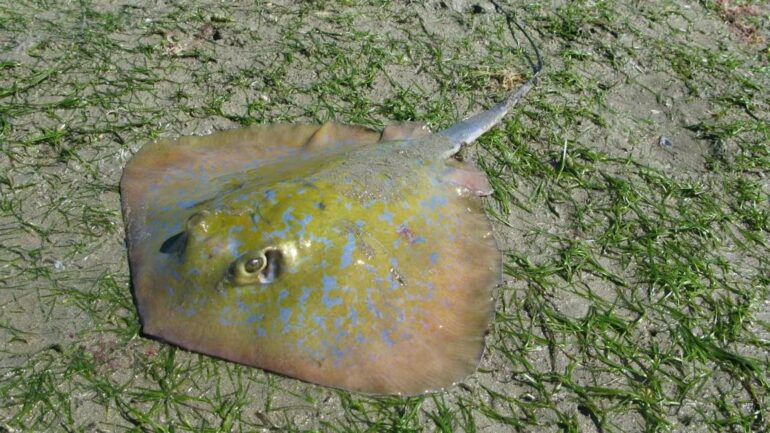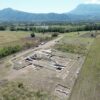South Africa’s Cape south coast offers many hints about how our human ancestors lived some 35,000 to 400,000 years ago during the Pleistocene epoch. These clues are captured in the dunes they once traversed, today cemented and preserved in a rock type known as aeolianite.
Our research team has been studying this area since 2008. We’ve described the fossilized tracks of large Pleistocene animals such as lion, rhinoceros, elephant, giant buffalo and crocodiles, as well as footprints left by hominins.
Then, in 2018, one of our “citizen scientist” supporters, Emily Brink, spotted an intriguing rock east of Still Bay, about 330km east of Cape Town. The rock was unusually symmetrical and was shaped uncannily like a stingray, minus the tail.
After careful study of the rock, we have published an academic article in the journal Rock Art Research in which we posit that it represents a sand-sculpture of a blue stingray (Dasyatis chrysonata). We believe that the sculpture might have begun with tracing a specimen in the sand.
Why do we use words like “posit” and “believe,” rather than being more confident and assertive? Firstly, we cannot prove our interpretation, and others cannot falsify it. It therefore represents speculation—although it is highly informed speculation based on our understanding of many tens of thousands of such rocks. Secondly, ancient palaeoart is rare in the archaeological record, and may be harder to recognize than more recent art: we really don’t know how much we don’t know.
However, if our interpretation is correct, there are a number of implications:
making sand sculptures or “sand castles,” as many of our children love to do on dunes and beaches today, is an activity that dates back at least to the Middle Stone Age, around 130,000 years ago
this would be the oldest known example of humans creating an image of a creature other than themselves—a form of representational art
tracing may be a stepping stone to later emergence of representational art in caves.
Incredible symmetry
The rock was found about 30km east of the Blombos Cave, which is renowned for its palaeoart. That includes an engraving on ochre dating back 77,000 years and a 73,000 year old drawing.
Directly dating the specimen would involve taking a large chunk out of it, thus damaging it—something we are not willing to consider. But dating of nearby rocks, using optically stimulated luminescence, suggests that it was created during the Middle Stone Age around 130,000 years ago.
The near-perfect outline and proportions are evident through comparing the symmetrical outline of the specimen with that of a blue stingray. Viewing the rock from behind shows further symmetry as well as evidence of what looks like a tail stub. (We find no evidence that the tail portion broke off recently, and speculate that it may have been intentionally “amputated” when the sculpture was created.)
We contend that either the artist was phenomenally gifted in recording such detail or that the image was traced. If it was traced, the disk width of less than 30cm implies that it was made from a male or small immature female.
The notion of tracing is related to both the size of the feature (similar to that of a stingray) and its near-perfect shape. In addition, the multiple levels of symmetry occur not only in the outline of the rock and in areas corresponding to the fins, but also in the pattern engraved on its surface.
Symmetry is always intriguing, and can have a number of origins, only one of which is human. But it always begs for an explanation, and such multiple levels of symmetry support a hominin origin: the possibility that the combination of multiple symmetrical features is due to chance alone is, in our view, remote. It has previously been reported by researchers that ancient hominins appreciated and recognized symmetry.
The ancient art record
So, where does our postulated sand sculpture fit into the emergence of art in the ancient record?
The magnificent corpus of western European rock art, beginning about 40,000 years ago, seems to emerge abruptly, as if out of nowhere, preceded mostly by abstract symbols from diverse global locations. There is an interval of around 90,000 years between when this purported stingray sand sculpture was created and the emergence of those works of art on the walls of caves in Europe, the most famous of which is France’s Chauvet Cave.
The concept of the world’s original art being in sand, and sand thus being the original canvas, provides ample time for these skills to be honed over the intervening millennia. The absence of such art in the archaeological record can simply be attributed to the absence of suitable rocks preserved from the intervening ages.
Indeed, ammoglyphs (patterns made in sand by ancestral hominins and now evident in rock) have only been reported from the Cape south coast. This is a reminder of the rarity of ancient palaeoart and the reality of taphonomic bias: leather and wood decay faster than bone, which decays faster than rock, and ancient palaeoart may have been more common than is suggested by the sparse examples in the archaeological record. Moreover, it reminds us that there are more forms to ancient rock art than engraving and painting or drawing.
A stepping stone
We suggest, therefore, that tracing in sand might form a possible “stepping stone” between abstract images and images of creatures created “from scratch.” A flattish animal such as a stingray would have provided a suitable model for tracing, compared with more three-dimensional varieties. We have tentatively suggested a sequence of progression of representational palaeoart from initial tracing in sand, to the creation of images in sand (through copying or from memory), and then to rock art.
Art is such an important part of our existence as humans. This means that ideas on how and when it began are of interest and importance to many. If our suggestion is correct, it would not only push back the time when our distant ancestors first created art of another species, but could also help explain what has until now seemed enigmatic: the seemingly sudden appearance of magnificent art on walls deep within caves in western Europe.
More information:
Charles W. Helm et al, A purported Pleistocene sandsculpture from South Africa, Rock Art Research (2024)
This article is republished from The Conversation under a Creative Commons license. Read the original article.
Citation:
Stingray sand ‘sculpture’ in South Africa may be oldest example of humans creating an image of another creature (2024, April 1)



